How Students Can Actively—and Easily—Fight Gentrification
A Look at Gentrification in Montreal and What You Can Do to Fight It
The Link spoke with Fred Burrill, an anti- gentrification organizer and PhD student at Concordia, and Hannah Brais, a housing and employment advocate at the Concordia Student Union’s off-campus Housing and Job Bank, to understand what gentrification is and the role that students play.
2_900_1350_90.jpg)
Fred Burrill and Luce Parisien face the abandoned Canada Malting factory on St. Ambroise St. The community action group À nous la Malting (The Malting is Ours), formed in February 2017, is trying to reclaim the space for social housing and community-oriented services. Burrill said his dream for the space includes an affordable grocery store, drugstore, and a post office, to ease the daily lives of residents of the west end of St. Henri.
“Where you live should not determine the ease of your daily life,” said Burrill.
1_900_600_90.jpg)
Burrill and Parisien take in an abandoned lot on St. Ambroise St. from the Woonerf St-Pierre, an alley that was converted into a green space for local residents in 2010. Burrill says the city contributes to the gentrification of the area by making the space more appealing to condo developers, calling the green alley “a motor for gentrification.”
Social housing units border this lot, explained Burrill. However, next to those are luxury apartments—he says three and a half units rented out for $1,500 a month.
4_900_1350_90.jpg)
New developments are sprouting around St. Remi St. and St. Ambroise St., the site of the old Canada Malting factory. A new bar, Riverside, bought the property bordering the building. The bar and its fenced-in terrace close off one of the access points to the Lachine Canal.
“People talk about the canal as a collective heritage,” Burrill said. “What was sort of common space is increasingly fenced in,” particularly by condo developments.
3_900_1349_90.jpg)
Burrill and Parisien sit in the Wooneurf. Burrill has lived in St. Henri for the last decade, while Parisien has lived in the area for the last 27 years.
“It’s changing fast, the neighbourhood,” Burrill said, adding that “tensions are lived out daily” between longtime-residents and newcomers. “It can be very alienating.”
“People talk about direct and indirect displacement,” Burrill continued. “The indirect displacement is you wake up in the morning, you leave the house, and you don’t recognize the place where you grew up or the place you’ve lived your adult life and all your neighbours and connections are all gone. It’s kind of a sense of dislocation, I would say.”
“Be a good neighbour and listen. Don’t come with an imposing set of values. Learn to learn, which is why you’re here anyways, right?” – Hannah Brais, HOJO
5_900_506_90.jpg)
The fast-changing Montreal skyline is seen from the Lachine Canal, just west of Griffintown. Until it closed to commercial ships in 1970, working- class communities inhabited the areas along the canal, employed by the nearby factories.
During the revitalization of Griffintown, the former home to Montreal’s Irish community, Burrill says “The City did the dirty work,” allowing gentri cation to move westwards.
7_900_600_90.jpg)
A depanneur on the corner of Ste. Catherine St. East and Jeanne-d’Arc Ave. in Hochelaga-Maisonneuve neighbours a high-end furniture store.
“I think Plateau, Hochelaga- Maisonneuve—these are really good examples of places that a lot students from the rest of Canada, the United States have moved to and […] by contrast to where they’re coming from, the rent is a lot cheaper,” explained Hannah Brais, a housing and employment advocate with the Concordia Student Union’s Housing and Job Bank.
“So they kind of price out people who traditionally would have been there.”
8_900_600_90.jpg)
A new condo development sits next to a triplex on a residential street in Hochelaga-Maisonneuve. Brais explained that this can happen, particularly in lower-income neighbourhoods that are in the midst of being gentrified, after landlords see the potential in renovating units and renting them out, either on short-term websites such as Airbnb or to higher-income folks.
Brais stressed that if a student believes they are being evicted under false pretenses—if the landlord says they’re taking the unit back for themselves, for instance—they have a right to contest the eviction in court, which she says is not as scary as it seems.
“Fight eviction […] don’t just roll with it. Inform yourself, know your rights, be assertive with your landlord,” said Brais.
“You owe this to your community, you owe this to your neighbourhood,” she continued. “You owe this to other students who might want to live in your neighbourhood one day.”
9_900_600_90.jpg)
Graffiti on a depanneur in St-Henri. When asked how students can help counter gentrification in their neighbourhoods, Burrill and Brais offered similar advice, to listen.
“We have such a diverse city, it’s really exciting to move to,” said Brais. “Before you come here, take the time to learn the history about the neighbourhoods. You’ll learn a lot and you’ll be a little more
sensitive to what you are moving into.” “It’s not as hard as one would think,” said Burrill. He advised students to become an active participant in their communities, by babysitting or walking a neighbour’s dog, for example.
“Be a good neighbour and listen,” Brais continued. “Don’t come with an imposing set of values. Learn to learn, which is why you’re here anyways, right?”

6_900_599_90.jpg)



1_600_375_90_s_c1.jpg)
__600_375_90_s_c1.jpg)